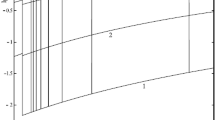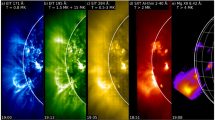Abstract
We have performed microwave diagnostics of the magnetic field strengths in solar flaring loops based on the theory of gyrosynchrotron emission. From Nobeyama Radioheliograph observations of three flare events at 17 and 34 GHz, we obtained the degree of circular polarization and the spectral index of microwave flux density, which were then used to map the magnetic field strengths in post-flare loops. Our results show that the magnetic field strength typically decreases from ∼800 G near the loop footpoints to ∼100 G at a height of 10–25 Mm. Comparison of our results with magnetic field modeling using a flux rope insertion method is also discussed. Our study demonstrates the potential of microwave imaging observations, even at only two frequencies, in diagnosing the coronal magnetic field of flaring regions.
Similar content being viewed by others
References
Lin H, Kuhn J R, Coulter R. Coronal magnetic field measurements. Astrophys J, 2004, 613: L177–L180
Lin H, Penn M J, Tomczyk S. A new precise measurement of the coronal magnetic field strength. Astrophys J, 2000, 541: L83–L86
Nakariakov V M, Ofman L. Determination of the coronal magnetic field by coronal loop oscillations. Astron Astrophys, 2001, 372: L53–L56
Chen Y, Feng S W, Li B, et al. A coronal seismological study with streamer waves. Astrophys J, 2011, 728: 147
Tian H, McIntosh S W, Wang T, et al. Persistent Doppler shift oscillations observed with HINODE/EIS in the solar corona: Spectroscopic signatures of Alfvenic waves and recurring upflows. Astrophys J, 2012, 759: 144
Schatten K H, Wilcox J M, Ness N F. A model of interplanetary and coronal magnetic fields. Sol Phys, 1969, 6: 442–455
Wiegelmann T, Sakurai T. Solar force-free magnetic fields. Living Rev Sol Phys, 2012, 9: 5
Wiegelmann T, Thalmann J K, Solanki S K. The magnetic field in the solar atmosphere. Astron Astrophys Rev, 2014, 22: 78
Gopalswamy N, Nitta N, Akiyama S, et al. Coronal magnetic field measurement from EUV images made by the Solar Dynamics Observatory. Astrophys J, 2012, 744: 72
Kishore P, Ramesh R, Hariharan K, et al. Constraining the solar coronal magnetic field strength using split-band type II radio burst observations. Astrophys J, 2016, 832: 59
Kumari A, Ramesh R, Kathiravan C, et al. Strength of the solar coronal magnetic field—A comparison of independent estimates using contemporaneous radio and white-light observations. Sol Phys, 2017, 292: 161
Kumari A, Ramesh R, Kathiravan C, et al. Direct estimates of the solar coronal magnetic field using contemporaneous extreme-ultraviolet, radio, and white-light observations. Astrophys J, 2019, 881: 24
Du G, Kong X, Chen Y, et al. An observational revisit of band-split solar type-II radio bursts. Astrophys J, 2015, 812: 52
Du G, Chen Y, Lv M, et al. Temporal spectral shift and polarization of a band-splitting solar type II radio burst. Astrophys J, 2014, 793: L39
Tan B L, Karlicky M, Meszarosova H, et al. Diagnosing physical conditions near the flare energy-release sites from observations of solar microwave type III bursts. Res Astron Astrophys, 2016, 16: 013
Feng S W, Chen Y, Li C Y, et al. Harmonics of solar radio spikes at metric wavelengths. Sol Phys, 2018, 293: 39
Tan B L, Yan Y H, Tan C M, et al. Microwave zebra pattern structures in the X2.2 solar flare on 2011 February 15. Astrophys J, 2012, 744: 166
Akhmedov S H B, Gelfreikh G B, Bogod V M, et al. The measurement of magnetic fields in the solar atmosphere above sunspots using gyro-resonance emission. Sol Phys, 1982, 79: 41–58
Akhmedow S B, Borovik V N, Gelfreikh G B, et al. Structure of a solar active region from RATAN 600 and very large array observations. Astrophys J, 1986, 301: 460–464
Bogod V M, Yasnov L V. On the comparison of radio-astronomical measurements of the height structure of magnetic field with results of model approximations. Astrophys Bull, 2009, 64: 372–385
Kaltman T I, Bogod V M, Stupishin A G, et al. The altitude structure of the coronal magnetic field of AR 10933. Astron Rep, 2012, 56: 790–799
Wang Z, Gary D E, Fleishman G D, et al. Coronal magnetography of a simulated solar active region from microwave imaging spectropolarimetry. Astrophys J, 2015, 805: 93
Anfinogentov S A, Stupishin A G, Myshyakov I I, et al. Record-breaking coronal magnetic field in solar active region 12673. Astrophys J, 2019, 880: L29
Miyawaki S, iwai K, Shibasaki K, et al. Coronal magnetic fields derived from simultaneous microwave and euv observations and comparison with the potential field model. Astrophys J, 2016, 818: 8
Iwai K, Shibasaki K. Measurements of coronal and chromospheric magnetic fields using polarization observations by the Nobeyama Radioheliograph. Publ Astron Soc Jpn, 2013, 65: S14
Iwai K, Shibasaki K, Nozawa S, et al. Coronal magnetic field and the plasma beta determined from radio and multiple satellite observations. Earth Planet Sp, 2014, 66: 149
Ryabov B I, Pilyeva N A, Alissandrakis C E, et al. Coronal magnetography of an active region from microwave polarization inversion. Sol Phys, 1999, 185: 157–175
Ryabov B I, Maksimov V P, Lesovoi S V, et al. Coronal magnetography of solar active region 8365 with the SSRT and NoRH radio heliographs. Sol Phys, 2005, 226: 223–237
Huang G L. Diagnosis of coronal magnetic field and nonthermal electrons from Nobeyama observations of a simple flare. Adv Space Res, 2008, 41: 1191–1194
Huang G L, Li J P, Song Q W. The calculation of coronal magnetic field and density of nonthermal electrons in the 2003 October 27 microwave burst. Res Astron Astrophys, 2013, 13: 215–225
Huang G, Li J, Song Q, et al. Attenuation of coronal magnetic fields in solar microwave bursts. Astrophys J, 2015, 806: 12
Sharykin I N, Kuznetsov A A, Myshyakov I I. Probing twisted magnetic field using microwave observations in an M class solar flare on 11 February, 2014. Sol Phys, 2018, 293: 34
Gary D E, Chen B, Dennis B R, et al. Microwave and hard X-Ray observations of the 2017 September 10 solar limb flare. Astrophys J, 2018, 863: 83
Kuridze D, Mathioudakis M, Morgan H, et al. Mapping the magnetic field of flare coronal loops. Astrophys J, 2019, 874: 126
Li D, Yuan D, Su Y N, et al. Non-damping oscillations at flaring loops. Astron Astrophys, 2018, 617: A86
Dulk G A. Radio emission from the sun and stars. Annu Rev Astron Astrophys, 1985, 23: 169–224
Nakajima H, Nishio M, Enome S, et al. The Nobeyama Radioheliograph. Proc IEEE, 1994, 82: 705–713
Lemen J R, Title A M, Akin D J, et al. The Atmospheric Imaging Assembly (AIA) on the Solar Dynamics Observatory (SDO). Sol Phys, 2012, 275: 17–40
Scherrer P H, Schou J, Bush R I, et al. The Helioseismic and Magnetic Imager (HMI) investigation for the Solar Dynamics Observatory (SDO). Sol Phys, 2012, 275: 207–227
Pesnell W D, Thompson B J, Chamberlin P C. The Solar Dynamics Observatory (SDO). Sol Phys, 2012, 275: 3–15
Handy B N, Acton L W, Kankelborg C C, et al. The Transition Region and Coronal Explorer. Sol Phys, 1999, 187: 229–260
Scherrer P H, Bogart R S, Bush R I, et al. The solar oscillations investigation—Michelson Doppler Imager. Sol Phys, 1995, 162: 129–188
Domingo V, Fleck B, Poland A I. The SOHO mission: An overview. Sol Phys, 1995, 162: 1–37
Wu Z, Chen Y, Huang G, et al. Microwave imaging of a hot flux rope structure during the pre-impulsive stage of an eruptive M7.7 solar flare. Astrophys J, 2016, 820: L29
Huang J, Kontar E P, Nakariakov V M, et al. Quasi-periodic acceleration of electrons in the flare on 2012 July 19. Astrophys J, 2016, 831: 119
Carmichael H. A process for flares. NASA Spec Publ, 1964, 50: 451
Sturrock P A. Model of the high-energy phase of solar flares. Nature, 1966, 211: 695–697
Hirayama T. Theoretical model of flares and prominences. I: Evaporating flare model. Sol Phys, 1974, 34: 323–338
Kopp R A, Pneuman G W. Magnetic reconnection in the corona and the loop prominence phenomenon. Sol Phys, 1976, 50: 85–98
Kim S, Shibasaki K, Bain H M, et al. Plasma upflows and microwave emission in hot supra-arcade structure associated with an M1.6 limb flare. Astrophys J, 2014, 785: 106
Ning H, Chen Y, Wu Z, et al. Two-stage energy release process of a confined flare with double HXR peaks. Astrophys J, 2018, 854: 178
van Ballegooijen A A. Observations and modeling of a filament on the sun. Astrophys J, 2004, 612: 519–529
Su Y, Surges V, van Ballegooijen A, et al. Observations and magnetic field modeling of the flare/coronal mass ejection event on 2010 April 8. Astrophys J, 2011, 734: 53
Chen Y, Tian H, Su Y, et al. Diagnosing the magnetic field structure of a coronal cavity observed during the 2017 total solar eclipse. Astrophys J, 2018, 856: 21
Yan Y, Zhang J, Wang W, et al. The Chinese Spectral Radioheliograph—CSRH. Earth Moon Planet, 2009, 104: 97–100
van Haarlem M P, Wise M W, Gunst A W, et al. LOFAR: The LOw-Frequency ARray. Astron Astrophys, 2013, 556: A2
Tingay S J, Goeke R, Bowman J D, et al. The Murchison Widefield Array: The square kilometre array precursor at low radio frequencies. Publ Astron Soc Aust, 2013, 30: E007
Perley R A, Chandler C J, Butler B J, et al. The Expanded Very Large Array: A new telescope for new science. Astrophys J, 2011, 739: L1
Chen X, Yan Y, Tan B, et al. Quasi-periodic pulsations before and during a solar flare in AR 12242. Astrophys J, 2019, 878: 78
Chen B, Yu S, Battaglia M, et al. Magnetic reconnection null points as the origin of semirelativistic electron beams in a solar jet. Astrophys J, 2018, 866: 62
Mohan A, McCauley P I, Oberoi D, et al. A weak coronal heating event associated with periodic particle acceleration episodes. Astrophys J, 2019, 883: 45
Chen Y J, Tian H, Zhu X S, et al. Solar ultraviolet bursts in a coordinated observation of IRIS, Hinode and SDO. Sci China Tech Sci, 2019, 62: 1555–1564
Huang Z, Xia L, Nelson C J, et al. Magnetic braids in eruptions of a spiral structure in the solar atmosphere. Astrophys J, 2018, 854: 80
Author information
Authors and Affiliations
Corresponding author
Additional information
This work was supported by the Strategic Priority Research Program of Chinese Academy of Sciences (Grant No. XDA17040507), and the National Natural Science Foundation of China (Grant Nos. 11790300, 11790301, 11790302, 11790304, 11825301, 11973057, 11803002 and 11473071). We thank Dr. Yang Guo for helpful discussion.
Rights and permissions
About this article
Cite this article
Zhu, R., Tan, B., Su, Y. et al. Microwave diagnostics of magnetic field strengths in solar flaring loops. Sci. China Technol. Sci. 64, 169–178 (2021). https://doi.org/10.1007/s11431-020-1620-7
Received:
Accepted:
Published:
Issue Date:
DOI: https://doi.org/10.1007/s11431-020-1620-7




